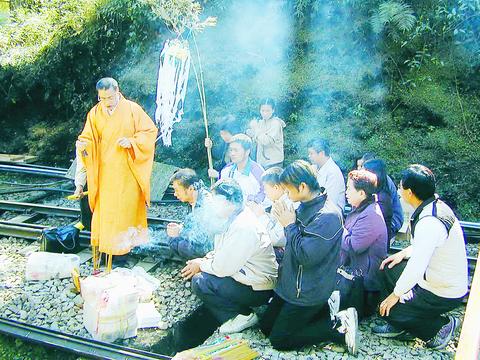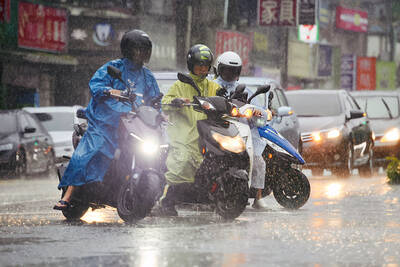Human error was the probable cause of the Alishan train accident on Saturday, Luo Chien-hsun (羅建勛), chief prosecutor of the Chiayi Prosecutors' Office, said yesterday.
Initial investigations showed that a stopcock which controlled the airbrake connection between the locomotive and the carriages had been inadvertently left closed.
The accident happened on Saturday afternoon when a four-carriage mountain train, packed with nearly 200 people, derailed shortly after leaving Alishan Railway Station. Seventeen people were killed.

PHOTO: YANG KUO-TANG, TAIPEI TIMES
The Council of Agriculture's Taiwan Forestry Bureau, which is responsible for the operation of the railway, said 156 people were injured.
"I have worked as a train driver for more than 20 years. It was the first time I met this kind of situation," the train's driver, Tsai Chen-sun (蔡振森), said yesterday.
"Three minutes after departing from Alishan Station, the train began traveling down a gradient. I felt clearly the train was speeding," Tsai said.
"I tried desperately to stop the train but the brakes failed. Then the train rammed into the mountain side," Tsai said.
Luo said the train brakes failed because the stopcock was closed.
"The two drivers and the conductor did not check the condition of the stopcock carefully before leaving Alishan Station," Luo said. "That's why the train's brakes failed when the train was traveling down the gradient."
Luo excluded the possibility that the train derailed because of overloading or track problems.
The Chiayi District Court refused a prosecutors' request to detain the two train drivers early yesterday morning. Nevertheless, Luo said the train's conductor and drivers would be sent before the court again on a charge of professional negligence.
Meanwhile, Huang Yu-hsing (黃裕星), director of COA's Forestry Bureau, held a press conference to respond to local media reports that the accident took place because the four-carriage train might be overloaded.
Some reports said that each carriage could only carry 25 passengers; therefore the capacity of the train should have only been 100 passengers whereas there were about 190 passengers aboard Saturday afternoon.
Huang said that the capacity of each carriage was in fact 40 seated and 10 standing passengers meaning that each train could carry 200 people.
There were certainly fewer than 200 aboard the train at the time of the accident, Huang said.
COA Chairman Lee Chin-lung (李金龍) apologized yesterday to the victims and their families and promised to increase the amount of compensation available.
"The family of each fatality can claim compensation as high as NT$7.1 million," Lee said. This compensation includes NT$4.1 million from the railway system's travel insurance and NT$2.4 million from the COA.
On top of this the COA will also give each family of a fatality NT$400,000 for a funeral and NT$200,000 condolence money.
The COA distributed yesterday a total of NT$8 million in compensation to families of the dead and the injured.
Moreover, Lee Jen-chyun (李健全), vice chairman of COA, said the operation of the railway will continue to be suspended until the cause of the tragedy is fully understood.
"The COA will also pay for every passenger's medical costs incurred in the accident," Lee said.
Also see story:

The combined effect of the monsoon, the outer rim of Typhoon Fengshen and a low-pressure system is expected to bring significant rainfall this week to various parts of the nation, the Central Weather Administration (CWA) said. The heaviest rain is expected to occur today and tomorrow, with torrential rain expected in Keelung’s north coast, Yilan and the mountainous regions of Taipei and New Taipei City, the CWA said. Rivers could rise rapidly, and residents should stay away from riverbanks and avoid going to the mountains or engaging in water activities, it said. Scattered showers are expected today in central and

COOPERATION: Taiwan is aligning closely with US strategic objectives on various matters, including China’s rare earths restrictions, the Ministry of Foreign Affairs said Taiwan could deal with China’s tightened export controls on rare earth metals by turning to “urban mining,” a researcher said yesterday. Rare earth metals, which are used in semiconductors and other electronic components, could be recovered from industrial or electronic waste to reduce reliance on imports, National Cheng Kung University Department of Resources Engineering professor Lee Cheng-han (李政翰) said. Despite their name, rare earth elements are not actually rare — their abundance in the Earth’s crust is relatively high, but they are dispersed, making extraction and refining energy-intensive and environmentally damaging, he said, adding that many countries have opted to

People can preregister to receive their NT$10,000 (US$325) cash distributed from the central government on Nov. 5 after President William Lai (賴清德) yesterday signed the Special Budget for Strengthening Economic, Social and National Security Resilience, the Executive Yuan told a news conference last night. The special budget, passed by the Legislative Yuan on Friday last week with a cash handout budget of NT$236 billion, was officially submitted to the Executive Yuan and the Presidential Office yesterday afternoon. People can register through the official Web site at https://10000.gov.tw to have the funds deposited into their bank accounts, withdraw the funds at automated teller

CONCESSION: A Shin Kong official said that the firm was ‘willing to contribute’ to the nation, as the move would enable Nvidia Crop to build its headquarters in Taiwan Shin Kong Life Insurance Co (新光人壽) yesterday said it would relinquish land-use rights, or known as surface rights, for two plots in Taipei’s Beitou District (北投), paving the way for Nvidia Corp to expand its office footprint in Taiwan. The insurer said it made the decision “in the interest of the nation’s greater good” and would not seek compensation from taxpayers for potential future losses, calling the move a gesture to resolve a months-long impasse among the insurer, the Taipei City Government and the US chip giant. “The decision was made on the condition that the Taipei City Government reimburses the related